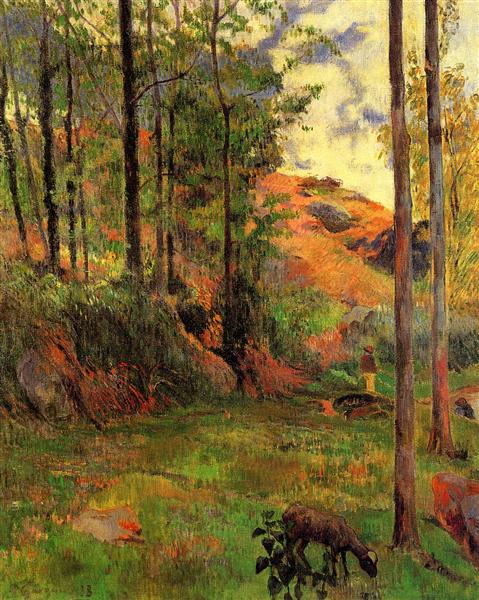Description
The painting "Road from Aveno" (1888) by Paul Gauguin is a work that encapsulates the spirit of his time and shows the distinctive features that positioned him as a key figure in post -impressionism. This painting, which represents a winding road descending to the Aven River in Brittany, is a testimony of its deep connection with nature and its search for a more intense, more symbolic reality, which transcends pure visual representation.
The composition is organized almost architecturally; The road is presented as a diagonal line that guides the viewer's view towards the bottom, creating a sense of depth that invites exploration. This movement towards the horizon seems to suggest a physical and spiritual trip. The trees, arranged on both sides of the path, are stylized with a bold use of color, in shades of vibrant green and deep shadows. This chromatic choice not only provides a visual exuberance to the work, but also suggests an almost magical atmosphere, characteristic of the symbolism that Gauguin explored.
Color is one of the most fascinating aspects of this work. Gauguin uses a palette that combines both natural colors and more daring tones. The trees, with their green and golden leaves, contrast with the blue of the sky and the brown of the road, which causes a visual harmony that is curiously pleasant. This contrast shows Gauguin's experimentation with color as a means to express emotions and experiences, a technique that would influence later artistic movements.
Although in "path of descent to Aven" there are no human figures, the absence of characters does not remain vitality to the scene; On the contrary, its lack suggests an introspection and a dialogue between nature and the spectator. The empty path can be interpreted as a symbol of each person's personal trip, a contemplation space where nature becomes the only interlocutor. This idea is aligned with Gauguin's thought, who sought to distance himself from urban life and explore the landscapes that surrounded him, finding in them a sense of peace and reflection.
An interesting aspect of the work is its context. Painted in 1888, during the famous Gauguin stay in Pont-Aven, the work is part of a period in which the artist experienced intensely with light, color and shape. This is the same period that led him to develop his distinctive approach to symbolism, moving away from strict realism of impressionism. The artistic community in Pont-Aven was crucial for their training, since he and other artists, such as Émile Bernard, exchanged ideas and techniques, which culminated in the birth of what is known as the "Nabis" movement, which, which I sought to express emotions through painting.
"On the way down to Aven" is representative of this desire for escape and creative search for Gauguin, showing a landscape that, while being physical, evokes an emotional and spiritual experience. In its structure, color and symbolism, the work not only reflects a scene in Brittany, but also a state of the soul that resonates in art history, marking a milestone in the transition to modernity. Thus, the canvas stands not only as a representation of the visible world, but as a threshold towards the most intangible realities of existence.
KUADROS ©, a famous paint on your wall.
Hand-made oil painting reproductions, with the quality of professional artists and the distinctive seal of KUADROS ©.
Reproduction service paintings With a guarantee of satisfaction. If you are not completely satisfied with the replica of your painting, we refund your money 100%.

